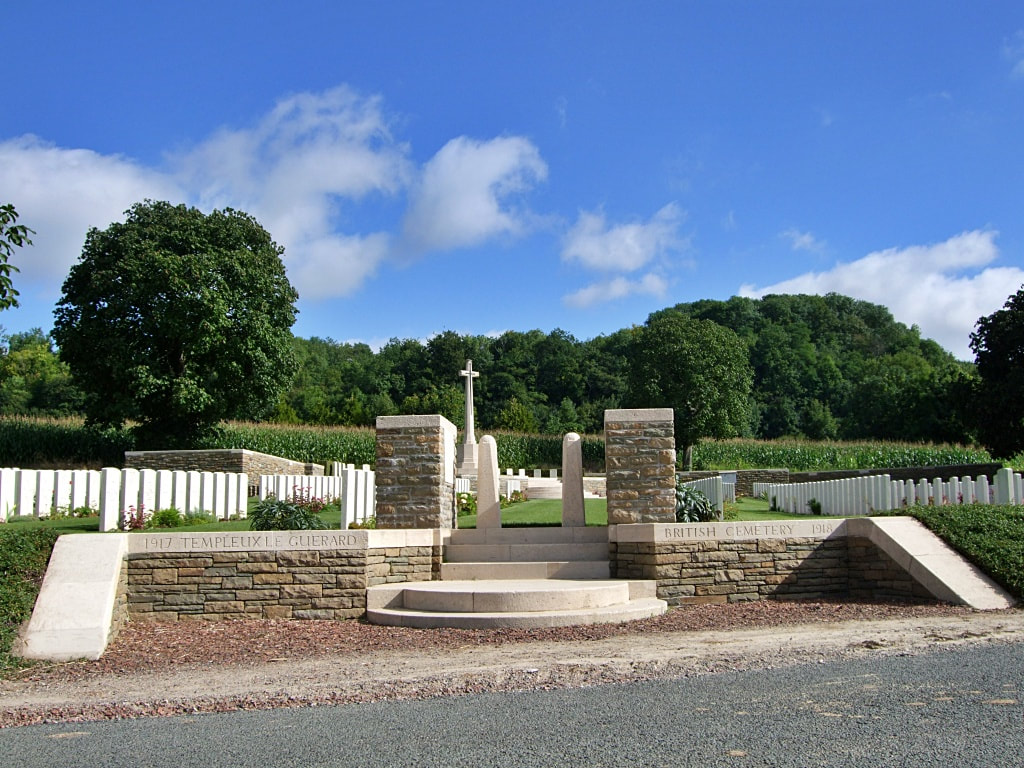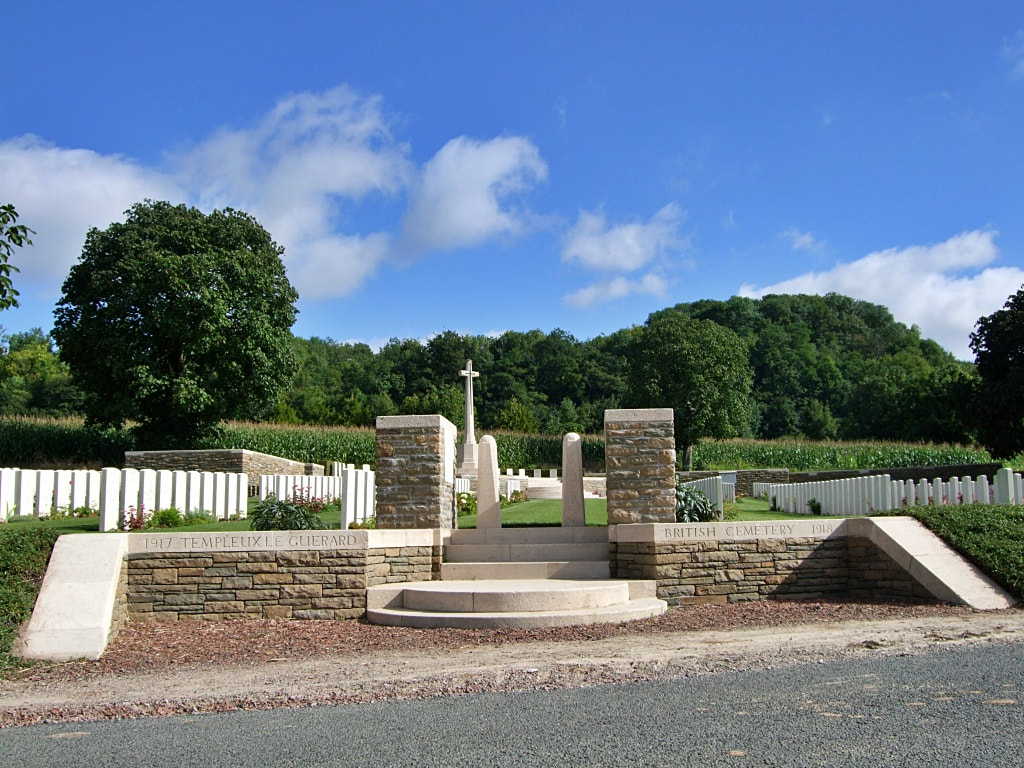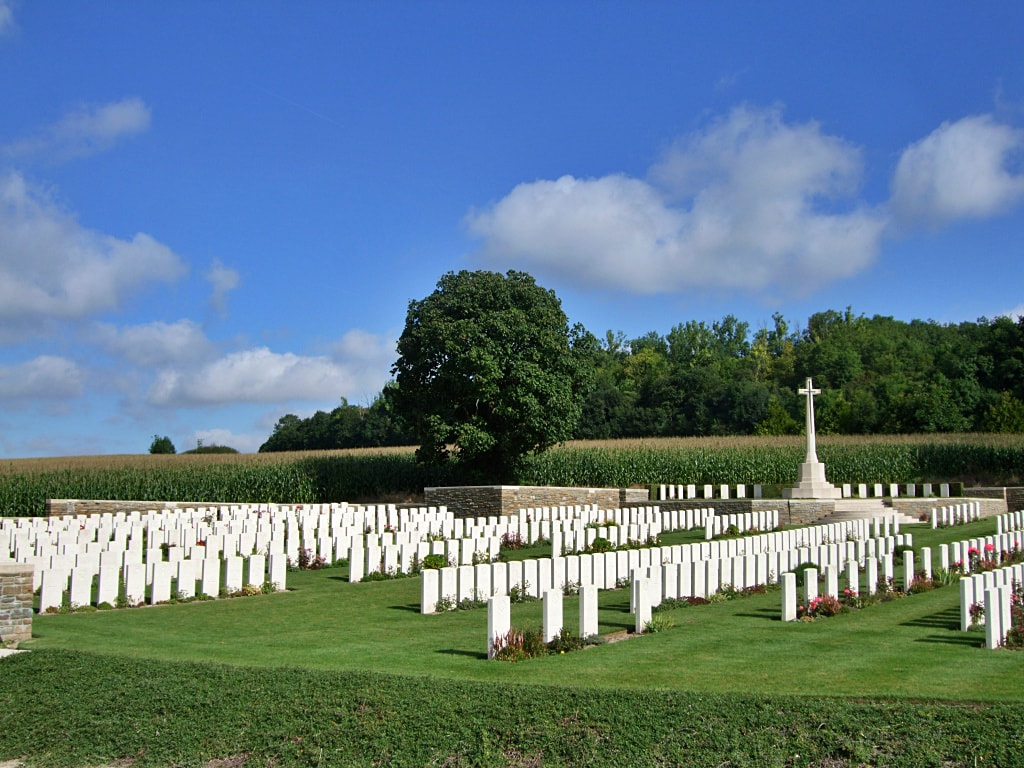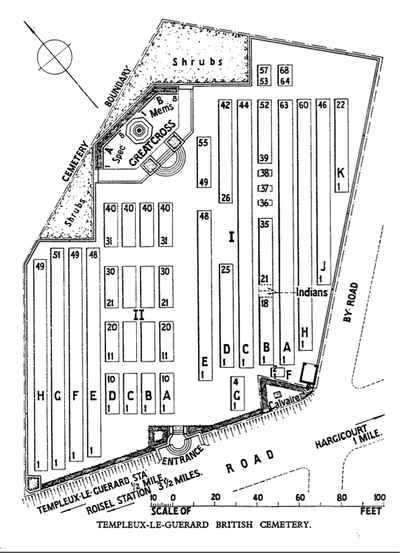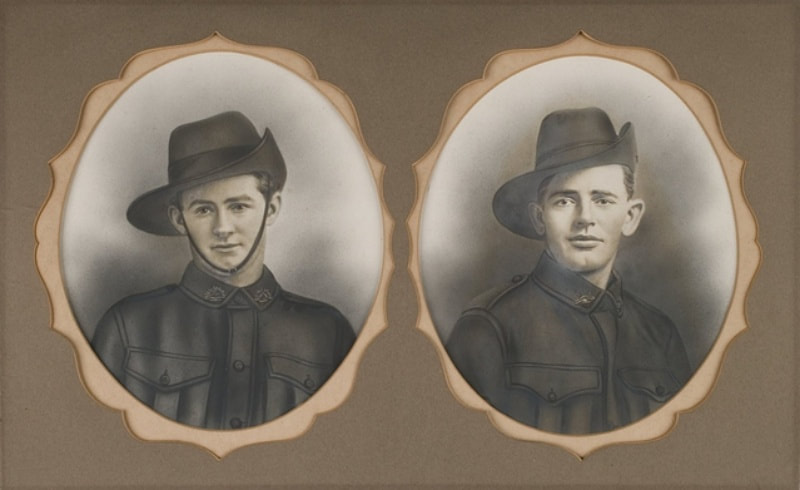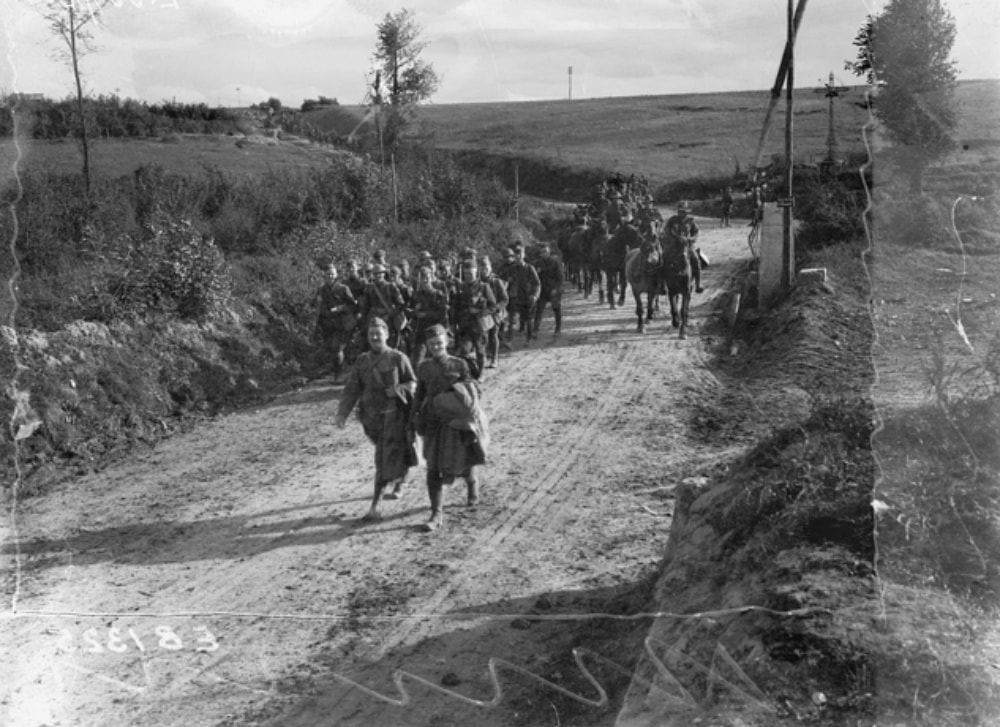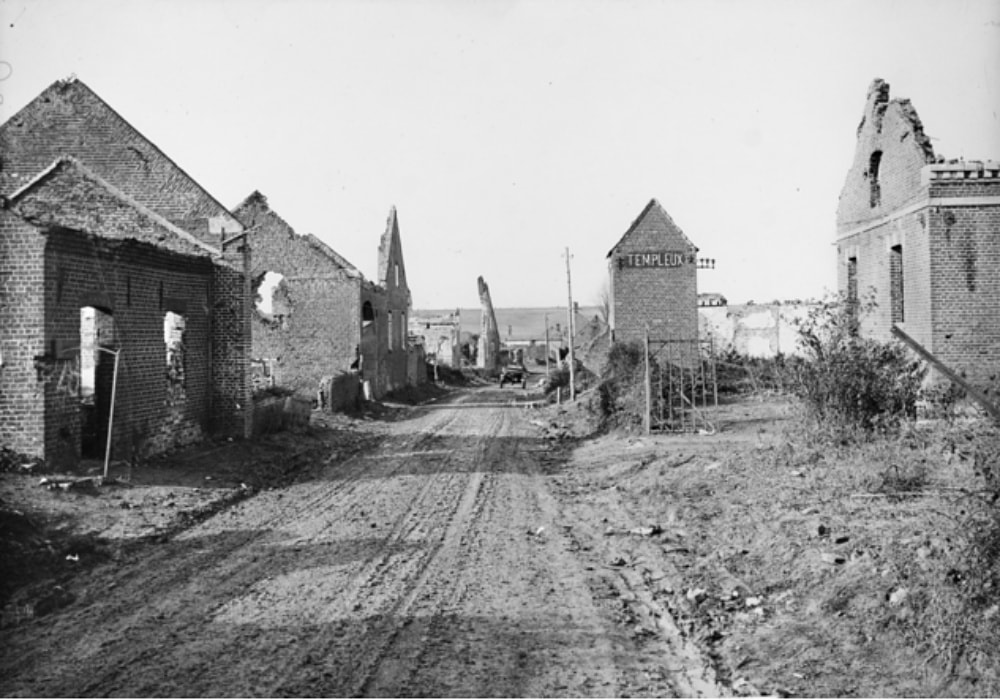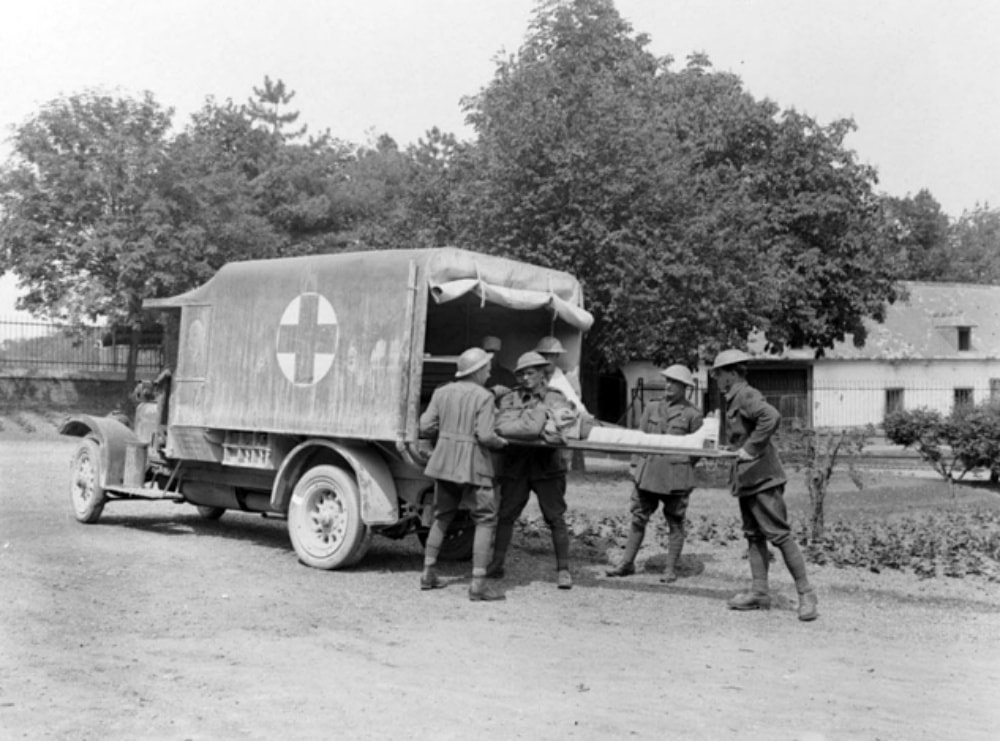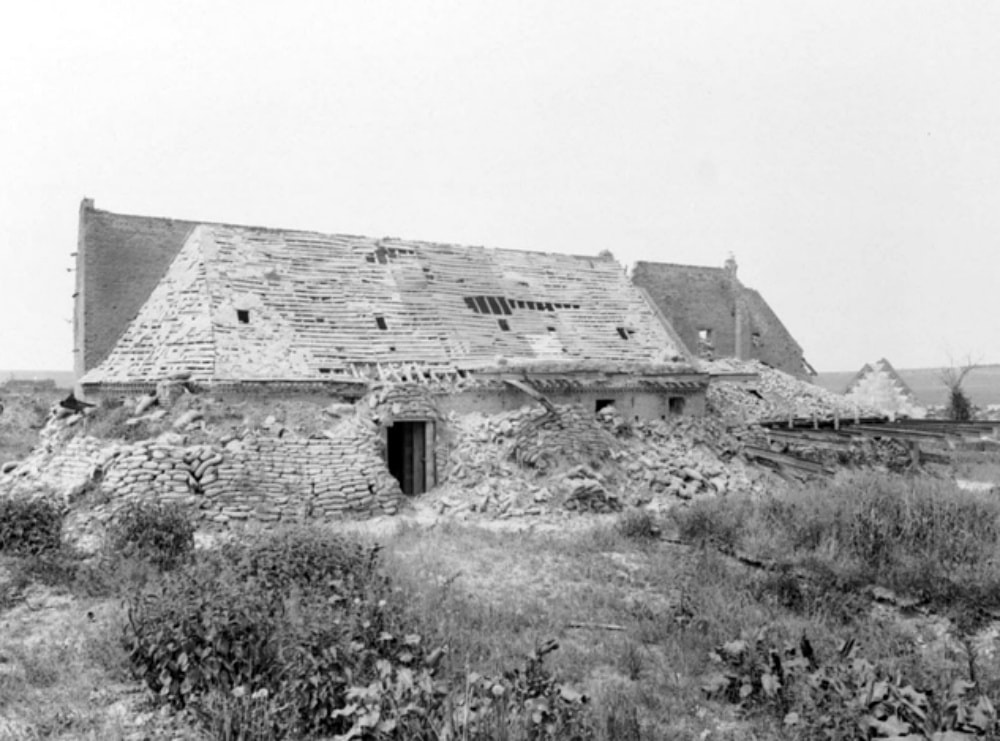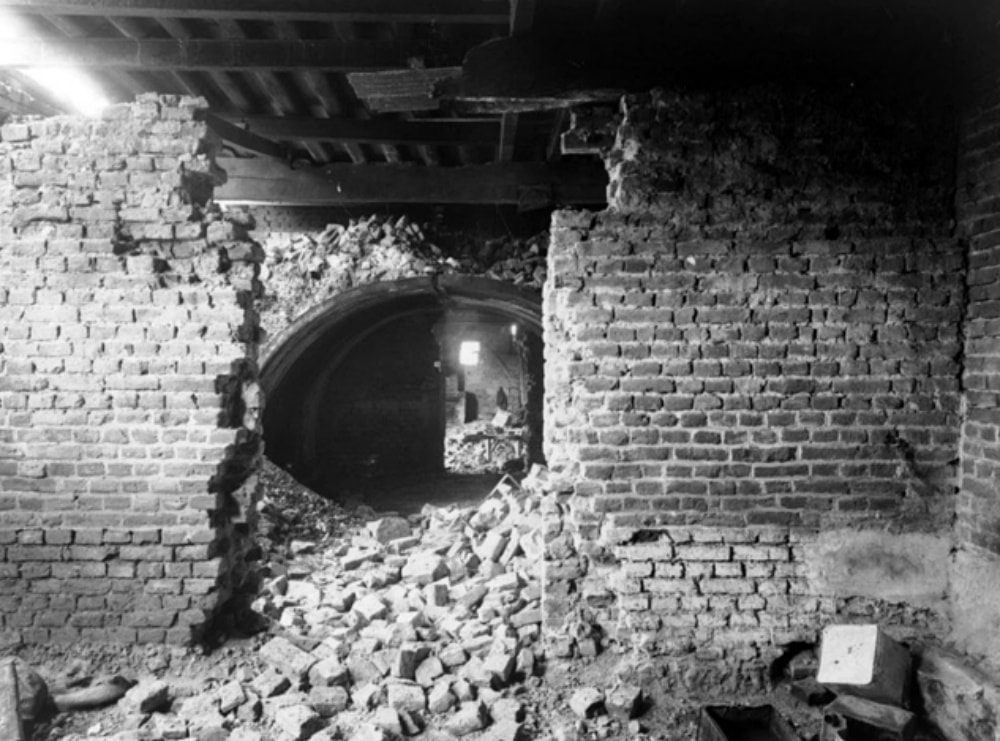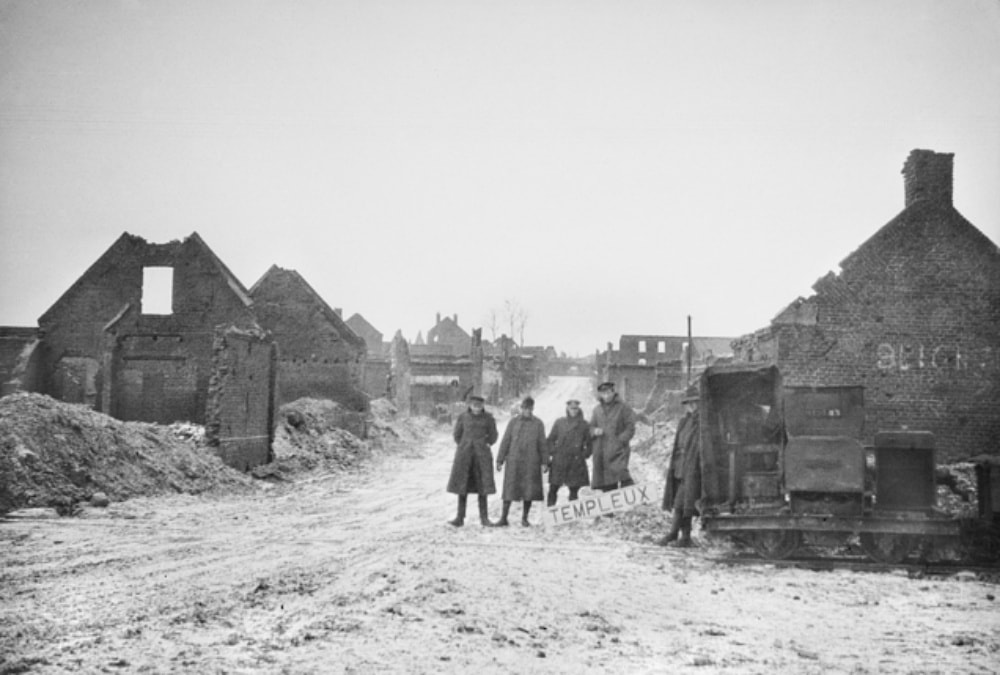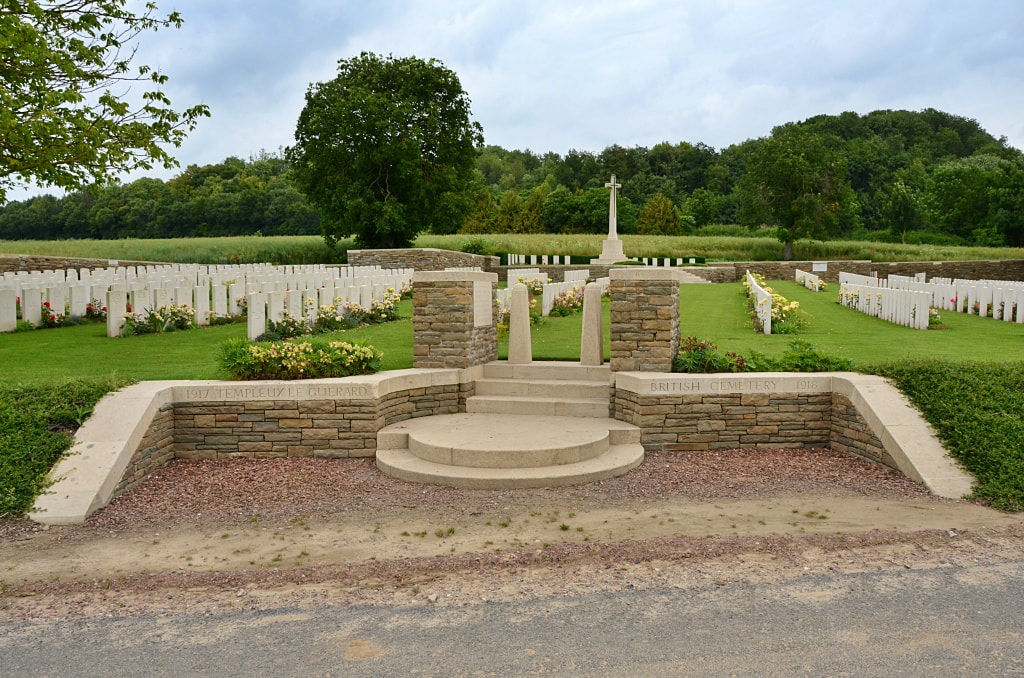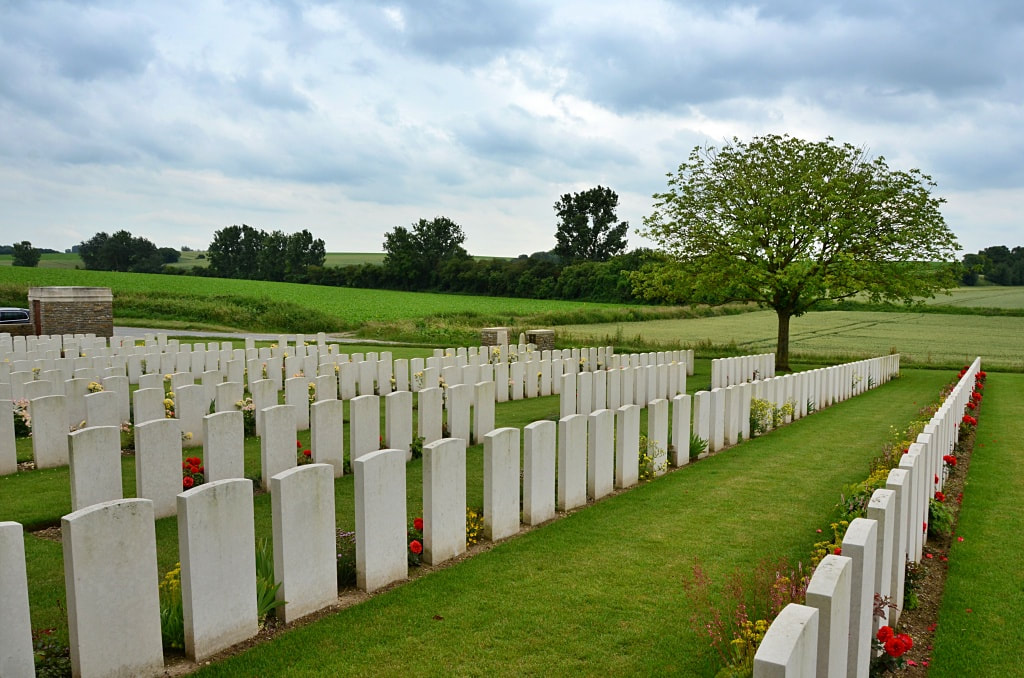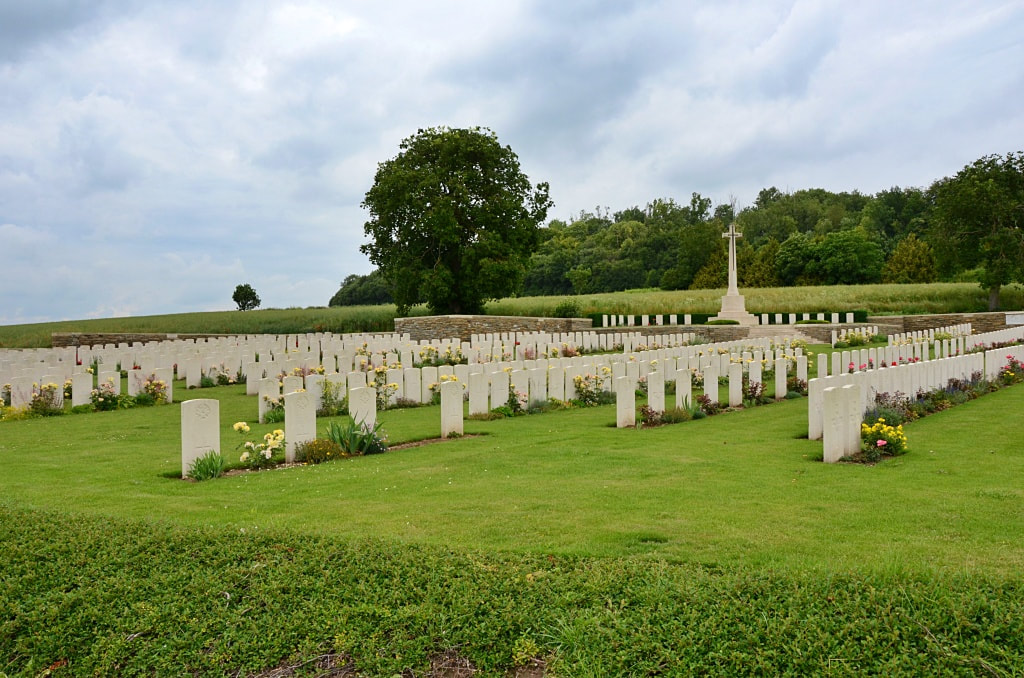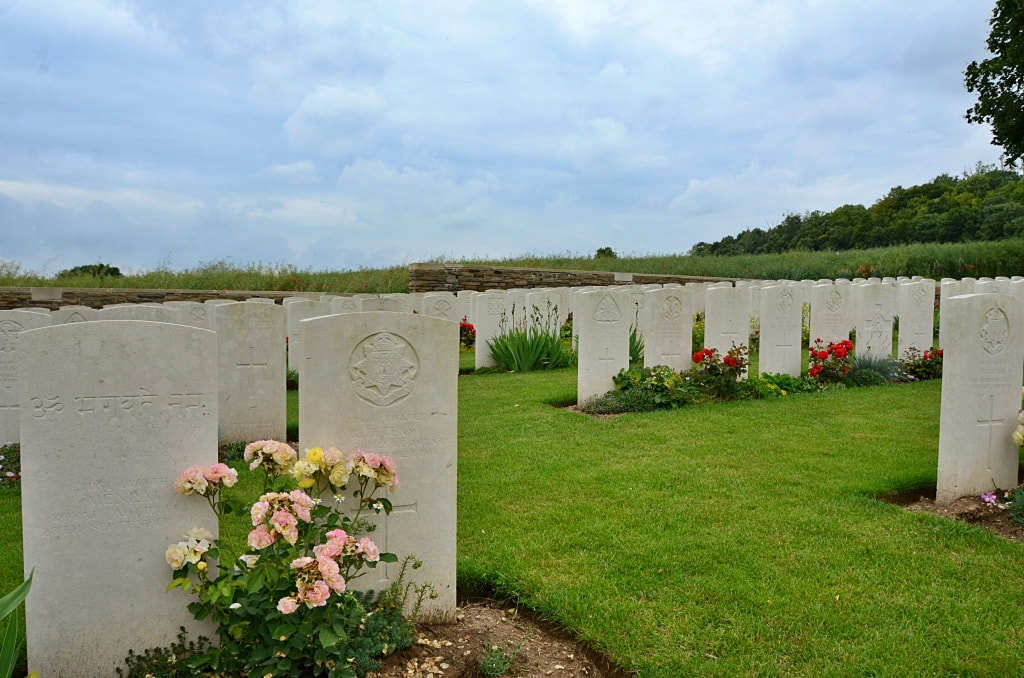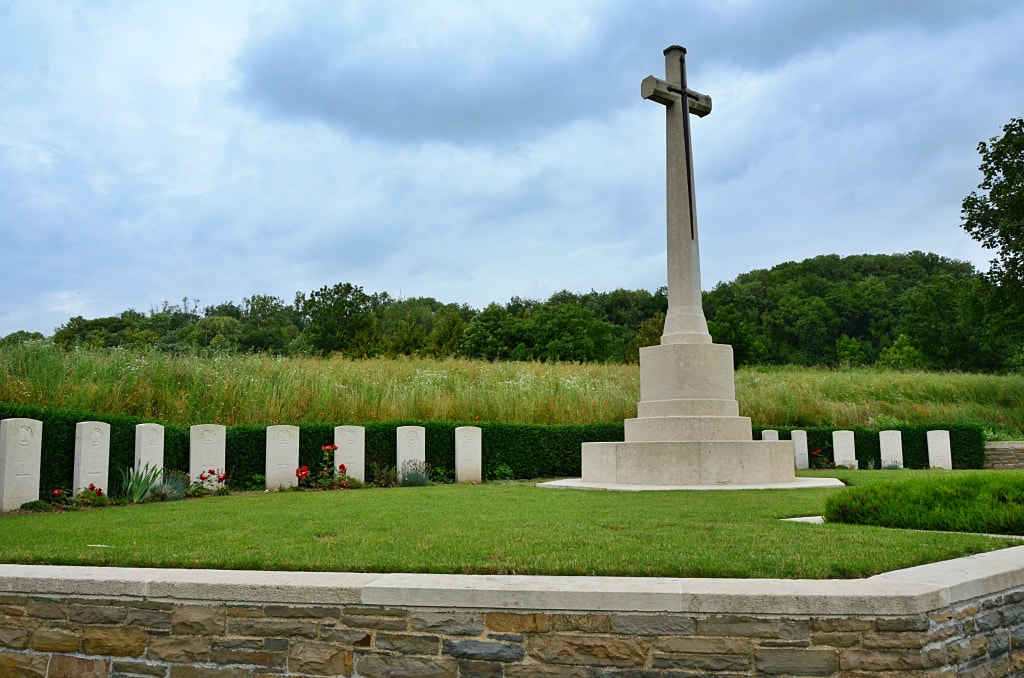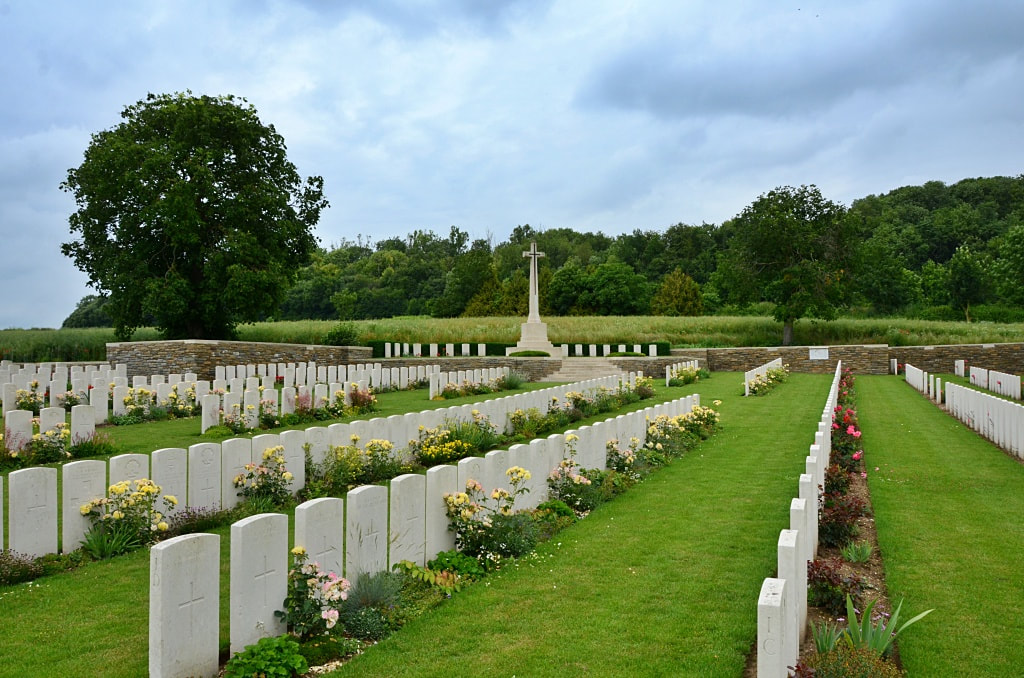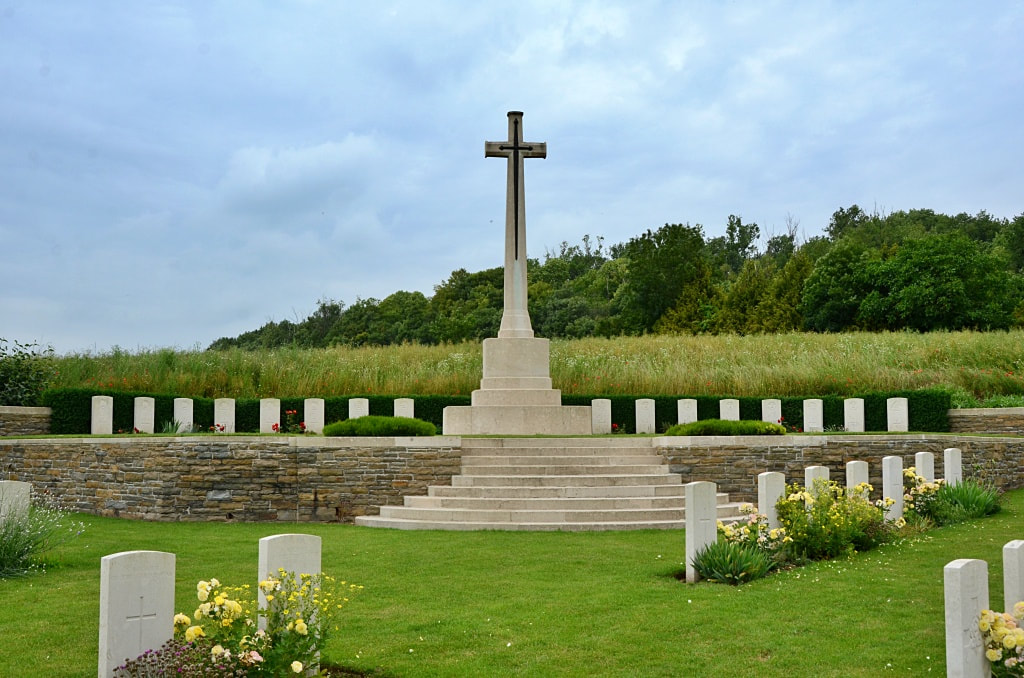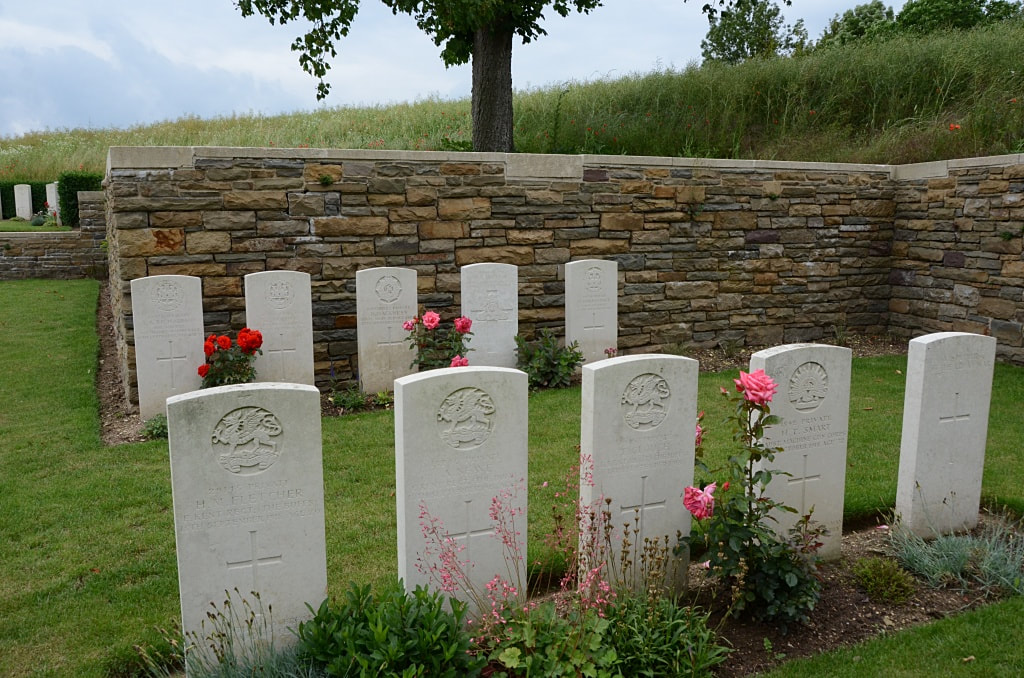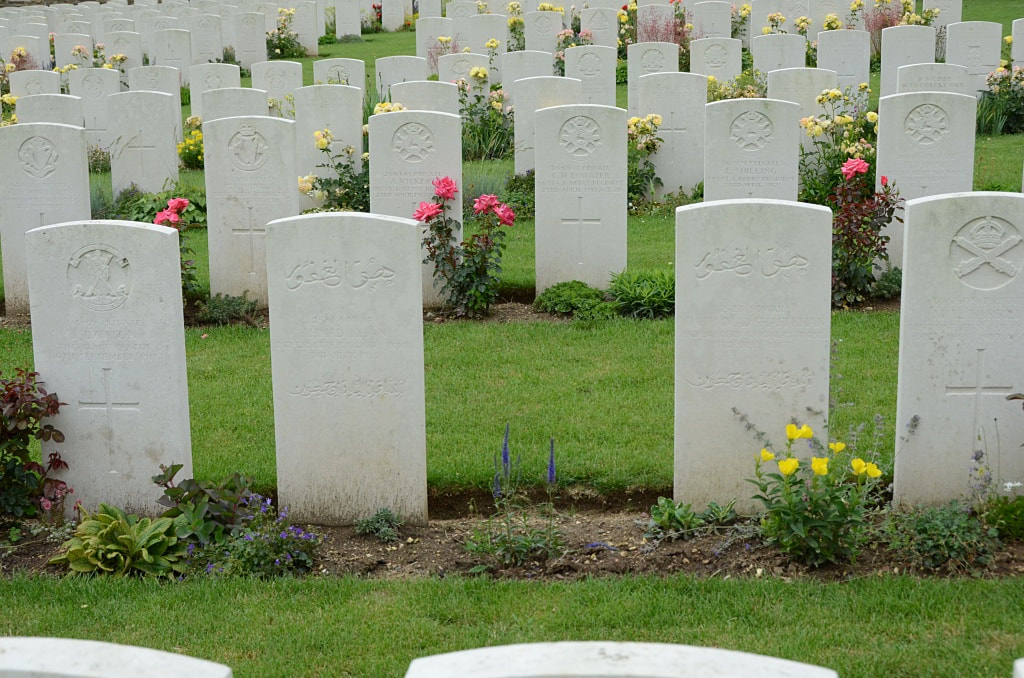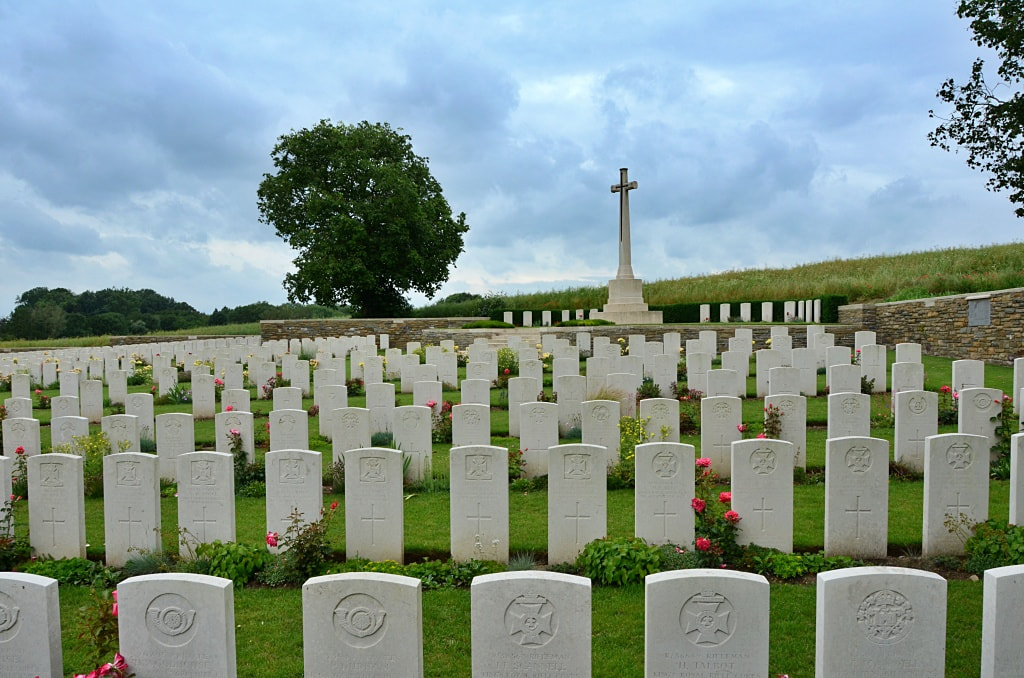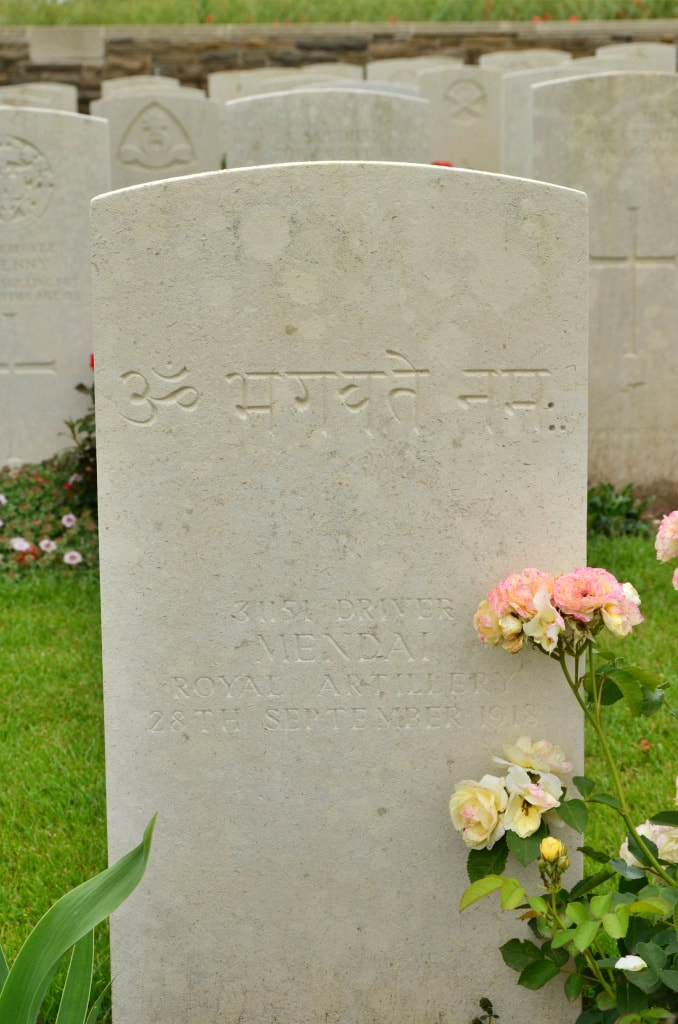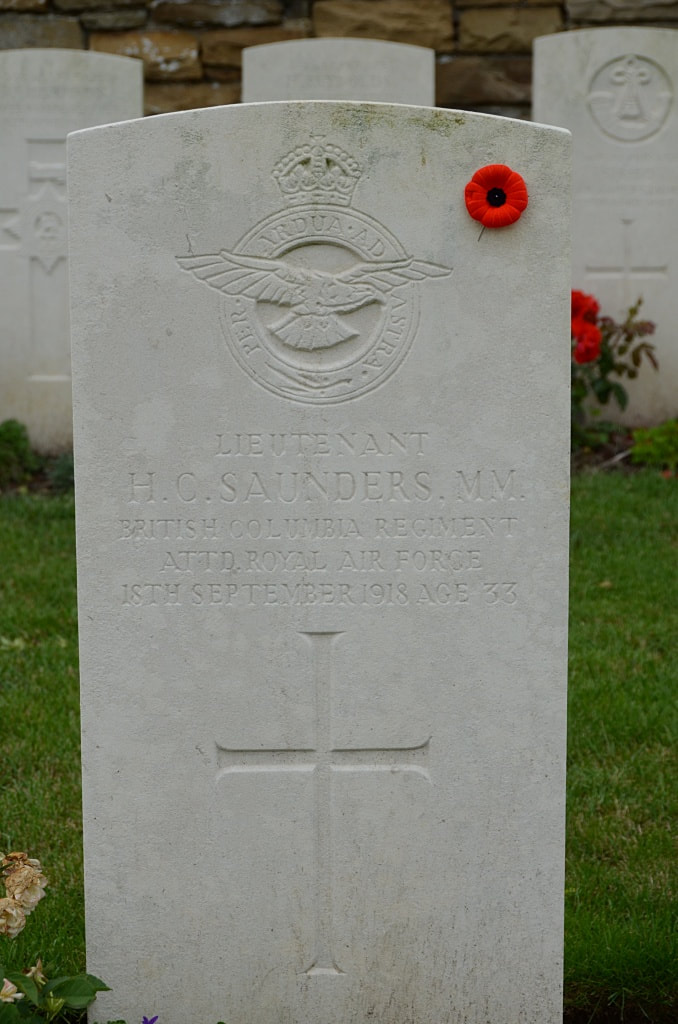TEMPLEUX-LE-GUÉRARD BRITISH CEMETERY
Somme
France
GPS Coordinates: Latitude: 49.96259, Longitude: 3.15761
Location Information
Templeux-le-Guérard is a village 26 kilometres east of Péronne. Templeux-le-Guérard British Cemetery is south-east of the village on the road to Haricourt.
Visiting Information
Wheelchair access to this cemetery is possible, but may be by an alternative entrance.
Historical Information
The village was taken early in April 1917, lost on the 21st March 1918, and retaken by the 15th Suffolks of the 74th (Yeomanry) Division on the following 18th September.
Templeux-Le-Guérard British Cemetery was begun by the 59th Division in April 1917, and carried on by other units until August 1917, and again in September and October 1918. After the Armistice, a further 360 graves were brought in from the battlefields (of April 1917 and March and September 1918) surrounding the village and in 1930, the British graves from the following two cemeteries were brought in:-
GOUY BRITISH CEMETERY (Aisne), was in the hamlet of Rue-Neuve (or Rue-du-Moulin), on the road from Gouy to Estrees. It stood in a paddock among pasture fields, close to a farmhouse. It was made by the 50th Division (as very recently reconstituted) in October 1918, and it contained the graves of 127 soldiers from the United Kingdom (almost all from that Division) and one from Australia; the dates of death were the 3rd-10th October, except for one soldier who died on the 18th. Le Catelet and Gouy were captured by the 50th Division on the 3rd October 1918.
STE EMILIE BRITISH CEMETERY, VILLERS-FAUCON, stood in the grounds of the Chateau of Ste Emilie, between the house and the railway station. It was begun by the 42nd (East Lancashire) Division in May 1917, carried on by Cavalry and other units and Field Ambulances until March 1918, and used again by British and American troops in September-November 1918. It contained the graves of 196 United Kingdom soldiers, 108 American, 22 Australian and one South African (the American graves, mainly of the 107th and 108th Infantry Regiments, were removed to Somme American Cemetery, Bony, before 1922). The American 27th and 30th Divisions, with Australian troops, attacked and carried the Hindenburg Line, a little East of Ste Emilie, on the 27th-30th September 1918.
There are 773, 1914-18 war casualties commemorated in this site. Of these, 188 are unidentified and special memorials are erected to 16 soldiers from the United Kingdom, known or believed to be buried among them.
The irregular lettering of the Rows is due to the concentrations of graves carried out after the Armistice.
The cemetery covers an area of 2,509 square metres and is enclosed on three sides by a low rubble wall.
The cemetery was designed by Sir Herbert Baker and Arthur James Scott Hutton
Total Burials: 773.
Identified Casualties: United Kingdom 536, Australia 44, India 3, Canada 1, South Africa 1. Total 585.
Unidentified Casualties: 188.
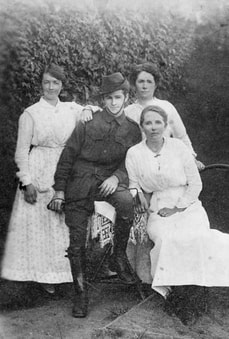
4134A Sergeant
Jonathan Yates Buckley
5th Australian Pioneers
3rd October 1918, aged 28.
Plot I. C. 43.
Click on image to enlarge
Outdoor portrait of 4134 (later 4134A) Private (Pte) Jonathan Yates Buckley, 2nd Battalion, with sisters Bid (left), Rose and Vi (seated). A coal miner from Corrimal, NSW, Buckley embarked with the 13th Reinforcements from Sydney aboard HMAT Aeneas on 20 December 1915. In February 1916 he was transferred to the 54th Battalion, and moved with his unit to France in June the same year. Pte Buckley was wounded twice by gun shot and shrapnel while serving in France, and promoted to the rank of Sergeant (Sgt) in November 1917.
Jonathan Yates Buckley
5th Australian Pioneers
3rd October 1918, aged 28.
Plot I. C. 43.
Click on image to enlarge
Outdoor portrait of 4134 (later 4134A) Private (Pte) Jonathan Yates Buckley, 2nd Battalion, with sisters Bid (left), Rose and Vi (seated). A coal miner from Corrimal, NSW, Buckley embarked with the 13th Reinforcements from Sydney aboard HMAT Aeneas on 20 December 1915. In February 1916 he was transferred to the 54th Battalion, and moved with his unit to France in June the same year. Pte Buckley was wounded twice by gun shot and shrapnel while serving in France, and promoted to the rank of Sergeant (Sgt) in November 1917.
Framed double portrait of brothers 4134 Private (Pte) Jonathan Yates Buckley (left), 2nd Battalion, and 4022 Pte Joseph William Buckley, 1st Battalion. Both brothers enlisted for service in mid 1915. A coal miner from Corrimal, NSW, Pte Jonathon Buckley was twice wounded while serving in France. Later transferred to the 54th Battalion, he was promoted to the rank of Sergeant (Sgt) in November 1917. On 4 October 1918, Sgt Buckley was killed in action, aged 28, and buried at Templeux-le-Guerard British Cemetery, France. Pte Joseph Buckley was seriously wounded in action while serving in France in early 1916, and after undergoing medical treatment in England he returned to Australia in October 1916.
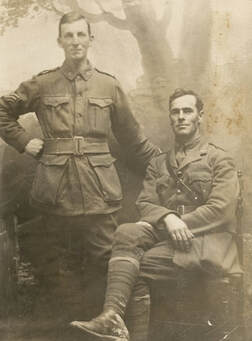
Lieutenant
Charles James Callan
38th Bn. Australian Infantry, A. I. F.
29th September 1916, aged 26.
Plot II. F. 42.
Inscription "In Proud Memory Of The Dear Husband Of Nellie Callan Loved By All"
Son of James Joseph and Mary Callan; husband of Nellie Callan, of 60, Gilpin Avenue, East Sheen, London, England. Born at Werribee.
Studio portrait of Lieutenant (Lt) Charles James Callan, 38th Battalion (right) and an unknown Sergeant, possibly his brother "Dick", (Left). Lt Callan, a bushman from Panton Hill Victoria, enlisted on 2 March 1915 and was given the regimental number 1065. He had been promoted to Sergeant by the time he embarked aboard HMAT A54 Runic from Port Melbourne on 20 June 1916. Lt Callan was killed in action near Rossny, France, on 29 September 1918. He was 28.
Charles James Callan
38th Bn. Australian Infantry, A. I. F.
29th September 1916, aged 26.
Plot II. F. 42.
Inscription "In Proud Memory Of The Dear Husband Of Nellie Callan Loved By All"
Son of James Joseph and Mary Callan; husband of Nellie Callan, of 60, Gilpin Avenue, East Sheen, London, England. Born at Werribee.
Studio portrait of Lieutenant (Lt) Charles James Callan, 38th Battalion (right) and an unknown Sergeant, possibly his brother "Dick", (Left). Lt Callan, a bushman from Panton Hill Victoria, enlisted on 2 March 1915 and was given the regimental number 1065. He had been promoted to Sergeant by the time he embarked aboard HMAT A54 Runic from Port Melbourne on 20 June 1916. Lt Callan was killed in action near Rossny, France, on 29 September 1918. He was 28.
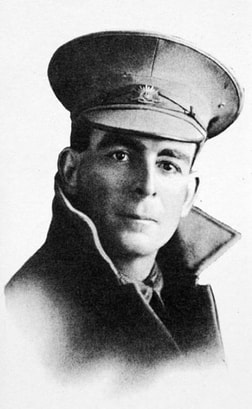
6723 Private
Eric Taylor Cook
2nd Bn. Australian Infantry, A. I. F.
18th September 1918, aged 34.
Plot I. E. 1.
Son of Alexander John and Alethia Isobel Cook, of 80, Belmont Rd., Mosman, New South Wales. Born at Sydney, New South Wales.
Studio portrait of 6723 Private Eric Taylor Cook, 2nd Battalion of Mosman, NSW. A bank clerk prior to enlisting, he embarked from Sydney aboard SS Port Nicholson on 8 November 1916. He was killed in action near Jeancourt, France on 18 September 1918 aged 34. His cousin 11143 Gunner Alfred Rowland Westbrook, 2nd Field Artillery Brigade, was killed in action on 27 August 1917 and is buried in Reninghelst New Military Cemetery in Belgium.
Eric Taylor Cook
2nd Bn. Australian Infantry, A. I. F.
18th September 1918, aged 34.
Plot I. E. 1.
Son of Alexander John and Alethia Isobel Cook, of 80, Belmont Rd., Mosman, New South Wales. Born at Sydney, New South Wales.
Studio portrait of 6723 Private Eric Taylor Cook, 2nd Battalion of Mosman, NSW. A bank clerk prior to enlisting, he embarked from Sydney aboard SS Port Nicholson on 8 November 1916. He was killed in action near Jeancourt, France on 18 September 1918 aged 34. His cousin 11143 Gunner Alfred Rowland Westbrook, 2nd Field Artillery Brigade, was killed in action on 27 August 1917 and is buried in Reninghelst New Military Cemetery in Belgium.
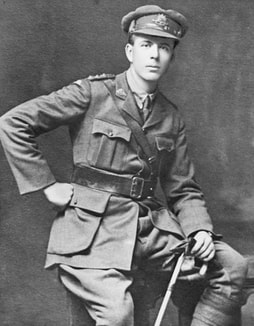
Captain
Francis Edward Fairweather, M. C. and Bar
38th Bn. Australian Infantry, A. I. F.
29th September 1918, aged 27.
Plot II. F. 41.
Inscription "He Came Not To Be Served But To Serve And Give His Life"
Son of John and Annie Mabel Fairweather, of Eaglemont, Heidelberg, Victoria, Australia.
Studio Portrait of Captain (Capt) Francis Edward Fairweather MC and Bar, 38th Battalion. A public accountant from Albert Park, Vic prior to enlistment, Capt Fairweather embarked with the rank of Lieutenant (Lt) with A Company from Melbourne on HMAT Runic on 20 June 1916. After being promoted to Captain, he was awarded the Military Cross for "most gallant conduct in the leadership of his company". Later he was awarded a Bar to his Military Cross for "conspicuous ability and devotion to duty".
Francis Edward Fairweather, M. C. and Bar
38th Bn. Australian Infantry, A. I. F.
29th September 1918, aged 27.
Plot II. F. 41.
Inscription "He Came Not To Be Served But To Serve And Give His Life"
Son of John and Annie Mabel Fairweather, of Eaglemont, Heidelberg, Victoria, Australia.
Studio Portrait of Captain (Capt) Francis Edward Fairweather MC and Bar, 38th Battalion. A public accountant from Albert Park, Vic prior to enlistment, Capt Fairweather embarked with the rank of Lieutenant (Lt) with A Company from Melbourne on HMAT Runic on 20 June 1916. After being promoted to Captain, he was awarded the Military Cross for "most gallant conduct in the leadership of his company". Later he was awarded a Bar to his Military Cross for "conspicuous ability and devotion to duty".
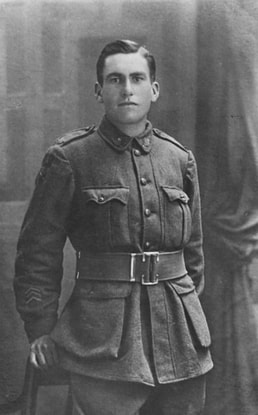
2410 Private
Frank Johnson Gates
1st Bn. Australian Machine Gun Corps
19th September 1918, aged 21.
Plot I. E. 28.
Inscription "In Memory Of Frank Youngest Son Of Mr. & Mrs. Gates Of Hurstville"
Youngest son of Arthur Henry and Elizabeth Temperance Gates, of "Arlington," Greenacre Rd., Hurstville, New South Wales, and brother of Sergeant George Henry Gates, M.M. Born at Petersham, New South Wales.
Studio portrait of 2410 Private Frank Johnston Gates, 1st Australian Machine Gun Battalion, of Petersham, NSW. An engineer prior to enlisting on 9 May 1915, he embarked aboard HMAS Orsova on 14 July 1915 from Sydney, NSW. He was killed in action at Hargicourt in France on 19 September 1918, aged 21. His brother, 7572 Sergeant George Henry Gates was killed in action at Bray approximately one month before on 8 August 1918 and is buried in Beacon Cemetery in France.
Frank Johnson Gates
1st Bn. Australian Machine Gun Corps
19th September 1918, aged 21.
Plot I. E. 28.
Inscription "In Memory Of Frank Youngest Son Of Mr. & Mrs. Gates Of Hurstville"
Youngest son of Arthur Henry and Elizabeth Temperance Gates, of "Arlington," Greenacre Rd., Hurstville, New South Wales, and brother of Sergeant George Henry Gates, M.M. Born at Petersham, New South Wales.
Studio portrait of 2410 Private Frank Johnston Gates, 1st Australian Machine Gun Battalion, of Petersham, NSW. An engineer prior to enlisting on 9 May 1915, he embarked aboard HMAS Orsova on 14 July 1915 from Sydney, NSW. He was killed in action at Hargicourt in France on 19 September 1918, aged 21. His brother, 7572 Sergeant George Henry Gates was killed in action at Bray approximately one month before on 8 August 1918 and is buried in Beacon Cemetery in France.
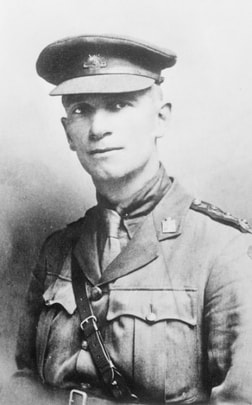
Chaplain 4th Class
The Reverend Alfred Ernest Goller
Australian Army Chaplains Department
29th September 1918, aged 35.
Plot II. F. 29.
Inscription "Semper Idem"
Son of John George Martin Goller and Matilda Goller; husband of Hilda Goller, of 81, South Rd., Brighton Beach, Victoria, Australia.
C. 1915. Portrait of Padre A. E. Goller, 37th Battalion. During the disbandment meeting in September 1916, when the men of the 37th Battalion refused to march off to their new battalions, Padre Goller who was instructed to fall out with the other officers, is reported to have replied "If ever the man need me it is now". Padre Goller was killed 19th September 1918 while collecting the belongings of men who had been killed. (Donor: W. Connell)
The Reverend Alfred Ernest Goller
Australian Army Chaplains Department
29th September 1918, aged 35.
Plot II. F. 29.
Inscription "Semper Idem"
Son of John George Martin Goller and Matilda Goller; husband of Hilda Goller, of 81, South Rd., Brighton Beach, Victoria, Australia.
C. 1915. Portrait of Padre A. E. Goller, 37th Battalion. During the disbandment meeting in September 1916, when the men of the 37th Battalion refused to march off to their new battalions, Padre Goller who was instructed to fall out with the other officers, is reported to have replied "If ever the man need me it is now". Padre Goller was killed 19th September 1918 while collecting the belongings of men who had been killed. (Donor: W. Connell)
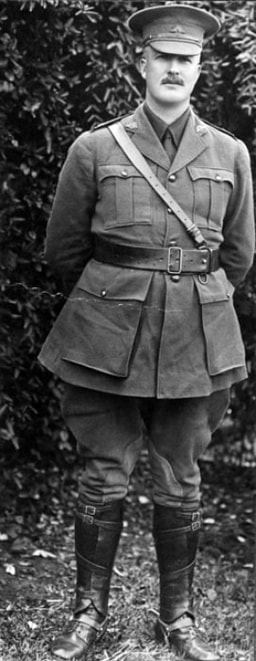
Lieutenant Colonel
Robert Oswald Henderson, D. S. O.
Australian Infantry, A. I. F.
29th September 1918, aged 43.
Plot II. F. 44.
Inscription "He Loved Chivalry Truth & Honor Freedom & Courtesy"
Son of Thomas Hope Henderson and Marian Henderson; husband of M. A. Henderson, of "Lorne Villa," Forest St., Bendigo, Victoria, Australia.
Lieutenant Colonel Robert Oswald Henderson DSO of the 39th Battalion, AIF, who was killed in action on 29 September 1918. (Donor Mrs M. Henderson)
'>Robert Oswald Henderson, D. S. O.
Australian Infantry, A. I. F.
29th September 1918, aged 43.
Plot II. F. 44.
Inscription "He Loved Chivalry Truth & Honor Freedom & Courtesy"
Son of Thomas Hope Henderson and Marian Henderson; husband of M. A. Henderson, of "Lorne Villa," Forest St., Bendigo, Victoria, Australia.
Lieutenant Colonel Robert Oswald Henderson DSO of the 39th Battalion, AIF, who was killed in action on 29 September 1918. (Donor Mrs M. Henderson)
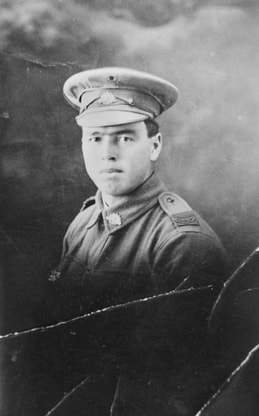
85/A Sergeant
Henry Joseph O'Brien
3rd Bn. Australian Machine Gun Corps
29th September 1918, aged 23.
Plot II. C. 22.
Son of William James and Ellen O'Brien. Born at Wellington, New South Wales.
Studio portrait of 85A Sergeant (Sgt) Henry Joseph O'Brien, 3rd Machine Gun Company, of Wellington, NSW, aged 20 years. Prior to enlisting in the AIF on 21 March 1916, he served with the 32nd Infantry, Citizens Military Forces. Sgt O'Brien embarked from Sydney aboard HMAT Benalla on 1 May 1916. He died of wounds on 29 September 1918 at Hargicourt, France. His cousin, 240 Private Leslie Glenmore O'Brien MM, also served with the AIF, as a member of the 4th Machine Gun Battalion. He died of wounds on 2 September 1918, aged 23 years and is buried at Daours Communal Cemetery Extension in France.
Henry Joseph O'Brien
3rd Bn. Australian Machine Gun Corps
29th September 1918, aged 23.
Plot II. C. 22.
Son of William James and Ellen O'Brien. Born at Wellington, New South Wales.
Studio portrait of 85A Sergeant (Sgt) Henry Joseph O'Brien, 3rd Machine Gun Company, of Wellington, NSW, aged 20 years. Prior to enlisting in the AIF on 21 March 1916, he served with the 32nd Infantry, Citizens Military Forces. Sgt O'Brien embarked from Sydney aboard HMAT Benalla on 1 May 1916. He died of wounds on 29 September 1918 at Hargicourt, France. His cousin, 240 Private Leslie Glenmore O'Brien MM, also served with the AIF, as a member of the 4th Machine Gun Battalion. He died of wounds on 2 September 1918, aged 23 years and is buried at Daours Communal Cemetery Extension in France.
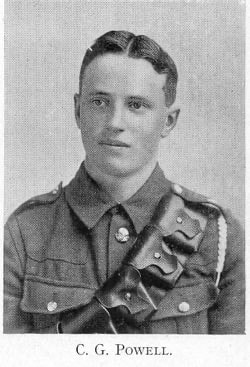
56717 Private
Cyril George Powell
74th Bn. Machine Gun Corps (Infantry) formerly Shropshire Yeomanry
20th September 1918, aged 21.
Plot II. C. 30.
Son of Thomas D. and Mary Powell, of Moreton Corbet, Shrewsbury. Also served in Egypt and Palestine.
The information below supplied by 'The Ellesmerian Club', the alumni organisation for Ellesmere College where Cyril was a pupil.
Cyril George Powell
74th Bn. Machine Gun Corps (Infantry) formerly Shropshire Yeomanry
20th September 1918, aged 21.
Plot II. C. 30.
Son of Thomas D. and Mary Powell, of Moreton Corbet, Shrewsbury. Also served in Egypt and Palestine.
The information below supplied by 'The Ellesmerian Club', the alumni organisation for Ellesmere College where Cyril was a pupil.
Cyril George Powell took up his place in the ‘Alfred’ dormitory and his desk in Form IV on his arrival at Ellesmere College on 29th April 1910. He was to stay for two years, leaving in December 1912, and was involved in many aspects of college life. On the academic side of life, very little is known apart from that he was active in the Debating Society and , on one occasion, he ‘trod the boards’, taking on the part of ‘Varro’ in the Shakespearian Society production of “Julius Caesar” (1912). He also enjoyed more intellectual challenges and played a brilliant series of games of chess to reach the final play-off in the 1912 competition – he lost.
Out on the playing fields, he represented his dormitory in hockey, cricket and football. He played several games for the college’s 1st XI football team, scoring five goals in one ‘demolition’ of Oswestry School, but he was only to win his 2nd XI colours. His performance that year was summarised in The Ellesmerian: “he combines well with his wing man, scored some excellent goals. Should learn to use his head more. Strong kick”.
George also played cricket for the college 1st XI team, with his average in 1912 season being 8·5, which placed him fourth overall in that year. One commentator wrote of his performance that season: Moderate bat. Has small range of scoring strokes. Very fair field.
He was a local boy, born on 26th November 1897, and his family farmed at Moreton Corbett, Shropshire. His parents, Thomas Dale Powell and Mary Elizabeth, came from Wem. He had three sisters, although one died in infancy, and one brother. Prior to his arrival at Ellesmere, he was educated at Shrewsbury Boys High School.
He enlisted in January 1915, initially in the 1/1st Battalion, the Shropshire Yeomanry and with them fought in Gaza and took part in the captures of Jerusalem and Jericho. The huge advances in mechanisation made the horse, as a ‘weapon’, almost redundant very early in the war – the advances in weaponry and new defences such as barbed wire and trenches also thwarted their use. As such, many mounted units combined and ‘dismounted’ to become infantry. This is what happened when the Shropshire and the Cheshire Yeomanry amalgamated.
George was now a Private in the 10th Battalion (Shropshire and Cheshire Yeomanry), the King’s Shropshire Light Infantry. By May 1918, he was Private Powell, Service No. 56717 in the 74th Machine Gun Corps. He fought at Bapaume and Épehy and it was during the fighting near here at Ronssoy that he was killed on 20thSeptember.
A full account of his death is given in the Moreton Corbett Parish Magazine:
He was buried at Templeux-Le-Guerard British Cemetery. His effects and his Medals were left to his father. His life is commemorated on memorials at St. Bartholemew’s Church, Moreton Corbet and at Ellesmere College.
Out on the playing fields, he represented his dormitory in hockey, cricket and football. He played several games for the college’s 1st XI football team, scoring five goals in one ‘demolition’ of Oswestry School, but he was only to win his 2nd XI colours. His performance that year was summarised in The Ellesmerian: “he combines well with his wing man, scored some excellent goals. Should learn to use his head more. Strong kick”.
George also played cricket for the college 1st XI team, with his average in 1912 season being 8·5, which placed him fourth overall in that year. One commentator wrote of his performance that season: Moderate bat. Has small range of scoring strokes. Very fair field.
He was a local boy, born on 26th November 1897, and his family farmed at Moreton Corbett, Shropshire. His parents, Thomas Dale Powell and Mary Elizabeth, came from Wem. He had three sisters, although one died in infancy, and one brother. Prior to his arrival at Ellesmere, he was educated at Shrewsbury Boys High School.
He enlisted in January 1915, initially in the 1/1st Battalion, the Shropshire Yeomanry and with them fought in Gaza and took part in the captures of Jerusalem and Jericho. The huge advances in mechanisation made the horse, as a ‘weapon’, almost redundant very early in the war – the advances in weaponry and new defences such as barbed wire and trenches also thwarted their use. As such, many mounted units combined and ‘dismounted’ to become infantry. This is what happened when the Shropshire and the Cheshire Yeomanry amalgamated.
George was now a Private in the 10th Battalion (Shropshire and Cheshire Yeomanry), the King’s Shropshire Light Infantry. By May 1918, he was Private Powell, Service No. 56717 in the 74th Machine Gun Corps. He fought at Bapaume and Épehy and it was during the fighting near here at Ronssoy that he was killed on 20thSeptember.
A full account of his death is given in the Moreton Corbett Parish Magazine:
He was buried at Templeux-Le-Guerard British Cemetery. His effects and his Medals were left to his father. His life is commemorated on memorials at St. Bartholemew’s Church, Moreton Corbet and at Ellesmere College.
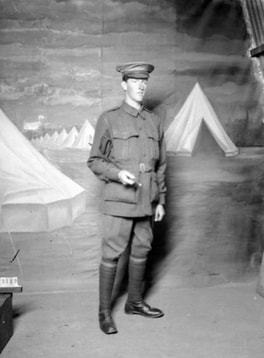
3628 Private
Norman Craib Rennie
10th Australian Ligh Trench Mortar Battery
27th September 1918, aged 26.
Plot II. F. 31.
Son of Alexander Ross Rennie and Ann E. Rennie. Born at Geelong, Victoria, Australia.
Studio portrait of 3628 Private (Pte) Norman Crabe (Craib) Rennie, 22nd Battalion, of Bairnsdale, Vic. Pte Rennie enlisted on 26 July 1915 and embarked aboard HMAT Afric on 5 January 1916. On 27 September 1918 he was killed in action at St Emilie in France while serving with the 10th Australian Light Trench Mortar Battery and defending the Hindenberg Line. On 5 October 1918 his brother 2nd Lieutenant George Ewen Rennie was killed in action on 5 October 1918 at Montbrehain and is buried in Tincourt New British Cemetery.
Norman Craib Rennie
10th Australian Ligh Trench Mortar Battery
27th September 1918, aged 26.
Plot II. F. 31.
Son of Alexander Ross Rennie and Ann E. Rennie. Born at Geelong, Victoria, Australia.
Studio portrait of 3628 Private (Pte) Norman Crabe (Craib) Rennie, 22nd Battalion, of Bairnsdale, Vic. Pte Rennie enlisted on 26 July 1915 and embarked aboard HMAT Afric on 5 January 1916. On 27 September 1918 he was killed in action at St Emilie in France while serving with the 10th Australian Light Trench Mortar Battery and defending the Hindenberg Line. On 5 October 1918 his brother 2nd Lieutenant George Ewen Rennie was killed in action on 5 October 1918 at Montbrehain and is buried in Tincourt New British Cemetery.
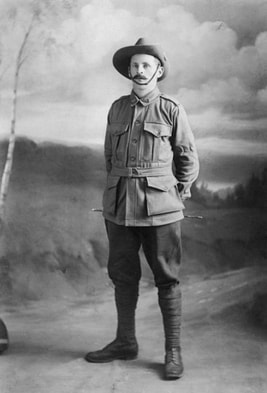
216 Private
Edward Ross
10th Australian Light trench Mortar Battery
27th September 1918.
Plot II. F. 30.
Studio portrait of 216 Private (Pte) Edward Ross, 39th Battalion, of Beech Forest, Vic. A labourer prior to enlisting in March 1916, Pte Ross embarked from Melbourne on board HMAT Ascanius (A11) on 27 May 1916. In August 1916 Pte Ross was transferred to the 10th Light Trench Mortar Battery and arrived for service in France in November. He was wounded in action in June 1917 and hospitalised in England until November, returning to France in February 1918. In May 1918 he contracted Influenza and several other illnesses followed. He finally rejoined his unit on 6 September 1918. Pte Ross was killed in action in France on 27 September 1918 during the Allied offensive against the Hindenburg Line. He was 33 years of age.
Edward Ross
10th Australian Light trench Mortar Battery
27th September 1918.
Plot II. F. 30.
Studio portrait of 216 Private (Pte) Edward Ross, 39th Battalion, of Beech Forest, Vic. A labourer prior to enlisting in March 1916, Pte Ross embarked from Melbourne on board HMAT Ascanius (A11) on 27 May 1916. In August 1916 Pte Ross was transferred to the 10th Light Trench Mortar Battery and arrived for service in France in November. He was wounded in action in June 1917 and hospitalised in England until November, returning to France in February 1918. In May 1918 he contracted Influenza and several other illnesses followed. He finally rejoined his unit on 6 September 1918. Pte Ross was killed in action in France on 27 September 1918 during the Allied offensive against the Hindenburg Line. He was 33 years of age.

